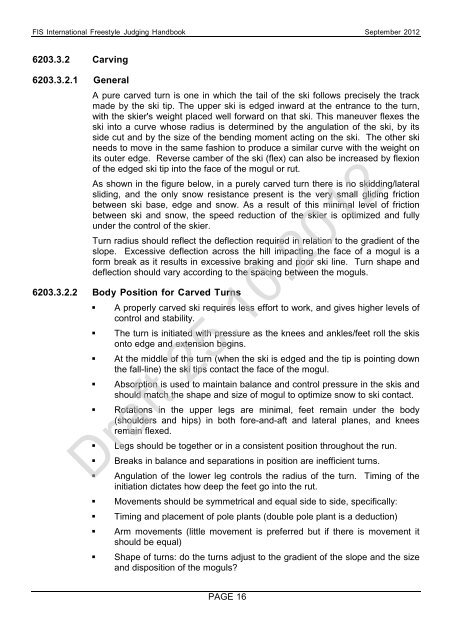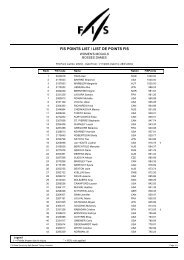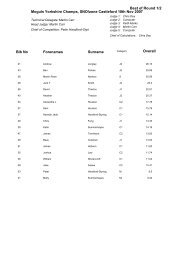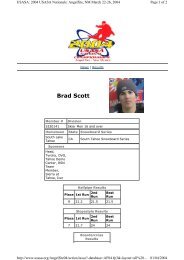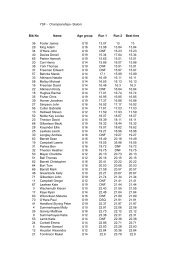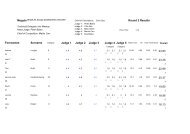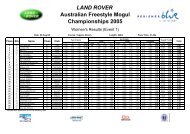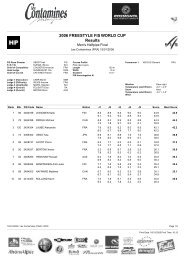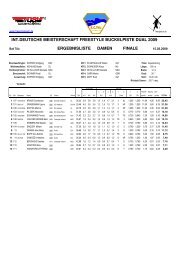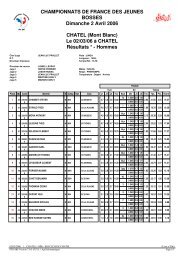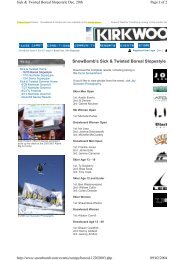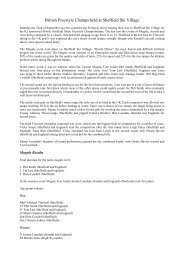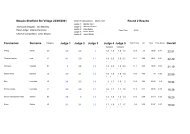AFP Judging Manual - Kent Freestyle
AFP Judging Manual - Kent Freestyle
AFP Judging Manual - Kent Freestyle
Create successful ePaper yourself
Turn your PDF publications into a flip-book with our unique Google optimized e-Paper software.
FIS International <strong>Freestyle</strong> <strong>Judging</strong> Handbook September 2012<br />
6203.3.2 Carving<br />
6203.3.2.1 General<br />
A pure carved turn is one in which the tail of the ski follows precisely the track<br />
made by the ski tip. The upper ski is edged inward at the entrance to the turn,<br />
with the skier's weight placed well forward on that ski. This maneuver flexes the<br />
ski into a curve whose radius is determined by the angulation of the ski, by its<br />
side cut and by the size of the bending moment acting on the ski. The other ski<br />
needs to move in the same fashion to produce a similar curve with the weight on<br />
its outer edge. Reverse camber of the ski (flex) can also be increased by flexion<br />
of the edged ski tip into the face of the mogul or rut.<br />
As shown in the figure below, in a purely carved turn there is no skidding/lateral<br />
sliding, and the only snow resistance present is the very small gliding friction<br />
between ski base, edge and snow. As a result of this minimal level of friction<br />
between ski and snow, the speed reduction of the skier is optimized and fully<br />
under the control of the skier.<br />
Turn radius should reflect the deflection required in relation to the gradient of the<br />
slope. Excessive deflection across the hill impacting the face of a mogul is a<br />
form break as it results in excessive braking and poor ski line. Turn shape and<br />
deflection should vary according to the spacing between the moguls.<br />
6203.3.2.2 Body Position for Carved Turns<br />
A properly carved ski requires less effort to work, and gives higher levels of<br />
control and stability.<br />
The turn is initiated with pressure as the knees and ankles/feet roll the skis<br />
onto edge and extension begins.<br />
At the middle of the turn (when the ski is edged and the tip is pointing down<br />
the fall-line) the ski tips contact the face of the mogul.<br />
Absorption is used to maintain balance and control pressure in the skis and<br />
should match the shape and size of mogul to optimize snow to ski contact.<br />
Rotations in the upper legs are minimal, feet remain under the body<br />
(shoulders and hips) in both fore-and-aft and lateral planes, and knees<br />
remain flexed.<br />
Legs should be together or in a consistent position throughout the run.<br />
Breaks in balance and separations in position are inefficient turns.<br />
Angulation of the lower leg controls the radius of the turn. Timing of the<br />
initiation dictates how deep the feet go into the rut.<br />
Movements should be symmetrical and equal side to side, specifically:<br />
Timing and placement of pole plants (double pole plant is a deduction)<br />
Arm movements (little movement is preferred but if there is movement it<br />
should be equal)<br />
Shape of turns: do the turns adjust to the gradient of the slope and the size<br />
and disposition of the moguls?<br />
PAGE 16


